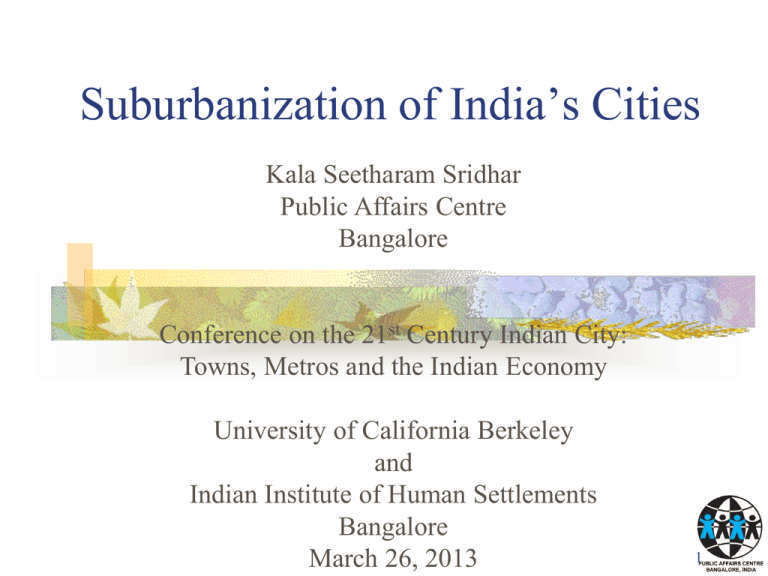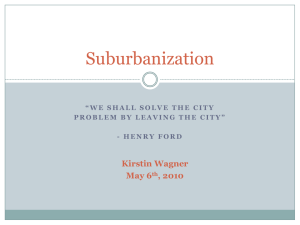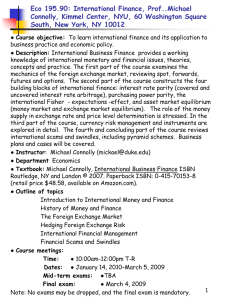Paper - The 21st Century Indian City
advertisement

Suburbanization of India’s Cities Kala Seetharam Sridhar Public Affairs Centre Bangalore Conference on the 21st Century Indian City: Towns, Metros and the Indian Economy University of California Berkeley and Indian Institute of Human Settlements Bangalore March 26, 2013 1 Presentation Overview General and b-suburbanization Theory Bangalore and other cities’ suburbanization Estimated and calculated density gradients for India’s cities Determinants of population and employment suburbanization Policy implications 2 Suburbanization of Population and Jobs in India, 1981-2001 % 1981 % 1991 %2001 % 1991 % 2001 Population Population Population Jobs Jobs suburban suburban suburban Suburban Suburban Average 20.67 21.33 Maximum 92.52 92.31 Minimum 0.18 0.05 Std.Dev 20.08 20.14 Observations 233 374 17.52% 87.19% 0.19% 0.18 336 21.76 92.85 0.12 20.11 374 17.94% 88.20% 0.17% 0.18 336 Sources: Sridhar (2007), 2001 Census PCA and author’s analyses 3 Population Suburbanization in India’s Metropolitan Areas, 1981-01 % Population % Population % Population suburban, suburban, suburban, 1981 1991 2001 Delhi 10 11 21 Kolkata 64 60 65 Mumbai NA* 21 27 Chennai 24 29 34 Sources: Sridhar (2007), 2001 Census PCA and author’s analyses 4 Suburbanization: Theoretical Framework Standard exponential population density function Gradient D(r) = D0e-br D(r) 14.0000 12.0000 10.0000 8.0000 6.0000 4.0000 2.0000 0.0000 CBD b1 = 0.4, D2(r) b2 = 0.8 D1(r) 1 3 5 7 9 11 13 15 17 19 R x (Distance from the CBD) D1(r) D2(r) 5 Bangalore: Density Function, 1991 1991 density 140000 120000 100000 80000 1991 density 60000 40000 20000 0 0 2 4 6 8 10 12 14 16 18 1991 municipal area: 126 sq km 6 Bangalore: Density Function, 2001 2001 density 120000 100000 80000 60000 2001 density 40000 20000 0 0 2 4 6 8 10 12 14 16 18 1991 municipal area: 226 sq km 7 Estimates of Population Density Functions for Bangalore, India, 1991 and 2001, Conventional City Center Dependent Variable: Natural logarithm of population density, 1991 Coeff. Std.Err. Intercept 9.17*** 0.28 Gradient (with conventional city 0.10*** 0.03 center), 1991 R2 0.18 Dependent Variable: Natural logarithm of population density, 2001 Coeff. Intercept 10.75*** Gradient (with conventional city center), -0.05*** 2001 R2 0.12 t-ratio 33.21 3.49 Std.Err. t-ratio 0.18 0.01 59.92 3.64 Number of observations=57 (wards) for 1991 regressions and 97 for 2001 regressions Source: Sridhar (2007) 8 Estimates of Population Density Functions for Bangalore, India, 1991 and 2001, New City Center Dependent Variable: Natural logarithm of population density, 1991 Coeff. 10.77*** -0.06*** Std.Err. 0.20 0.02 t-ratio 54.68 -3.94 Coeff. 10.79*** -0.05*** Std.Err. 0.11 0.01 t-ratio 97.82 -6.83 Intercept Gradient (with (ward 20) center) R2 0.22 Dependent Variable: Natural logarithm of population density, 2001 Intercept Gradient (with (ward 32) center) R2 0.33 Number of observations=57 (wards) for 1991 regressions and 97 for 2001 regressions Source: Sridhar (2007) 9 Two-Point Gradient Technique Lc L RC RC 0 0 Rc R LC 2rD( r )dr 2rD0 e br R R 0 0 L 2rD( r )dr 2rD0 e br 2D0 bRC bRC [ 1 e bR e ] C 2 b 2D0 bR bR [ 1 e bR e ] 2 b Lc 1 e bRc bRc e bRc L 1 e bR bR e bR 10 Summary of Population Density Gradients (Calculated) 1981 Average, all Maximum Minimum Std.Dev Observations Average, metros* Max, metros Min, metros Std.dev, metros 0.4783 0.9910 0.0117 0.2414 80 0.2467 0.3475 0.1870 0.0878 1991 (Same % Change 1981 (All subset as in (Same UAs) 1981) subset of UAs) 1981-91 0.4303 -10.04% 0.4933 0.9780 0.9910 -1.31% 0.0262 123.93% 0.0102 0.2397 0.2649 -0.70% 80 80 94 0.1963 NA -20.43% 0.2995 -13.81% NA 0.1244 -33.48% NA 0.0745 NA -15.15% Source: Sridhar (2007) 1991 (All % Change UAs) (all UAs) 1981-91 0.4669 0.9983 0.0072 0.2697 154 NA -5.35% 0.74% -29.41% 1.79% 77 -20.44% NA NA NA -13.81% -33.48% -15.08% 11 The Impact of Land Use Regulations on Population Suburbanization Variable Constant Population (in thousands) Income (in thousands) Proportion jobs suburbanized Number of local governments, 1981 Ratio of unemployment rate in central city to that in suburbs Ratio of literacy rate in central city to that in suburbs Ratio of SC/STs in central city to that in suburbs Lagged (1981) value of population gradient Maximum permissible residential FAR ULCRA (1=Yes; 0=No) Coeff. 0.5539** 0.0000 -0.0040 -0.1176 0.0026 Std.Err. 0.2807 0.0000 0.0028 0.1275 0.0038 t-ratio 1.9737 -0.6657 -1.4326 -0.9224 0.6803 Variable mean 0.0031 0.0079 0.3951 1.58 0.1639 0.1702 0.9631 1.03 -0.1340* 0.0752 -1.7825 0.81 0.5705*** 0.0966 5.9032 0.47 -0.0745** 0.0521 0.0349 0.0475 -2.1355 1.0969 2.34 0.40 Dependent variable mean= 0.44 R-squared= 0.57 Adjusted R-squared = 0.50 Number of observations= 68 869.04 63.88 0.30 6.60 Source: Sridhar (2007) 12 The Impact of Land Use Regulations on Employment Suburbanization Variable Constant Population (in thousands) Number of local governments, 1981 Worker emoluments as a proportion of value of output for state Proportion in labor force Ratio of literacy rate in central city to that in suburbs Ratio of SC/STs in central city to that in suburbs Lagged (1981) value of population gradient Proportion population suburbanized Maximum permissible non-residential FAR ULCRA (1=Yes; 0=No) Coeff. 0.2429 -0.0001** 0.0060 Std.Err. 0.2524 0.0000 0.0038 t-ratio 0.9623 -2.1372 1.5710 Variable mean 1.7022 -0.3128 2.1510 0.6001 0.7914 -0.5213 0.06 0.30 0.1034 0.1779 0.5810 1.02 -0.0675 0.0714 -0.9452 0.81 0.4876*** -0.2771** 0.1038 0.1342 4.6967 -2.0655 0.48 0.30 0.0005 -0.0198 0.0438 0.0664 0.0113 -0.2983 2.55 0.38 Dependent variable mean= 0.43 R-squared= 0.48 Adjusted R-squared = 0.38 Number of observations= 68 865.32 6.60 Source: Sridhar (2007) 13 Estimation of Welfare Gains Source: Brueckner & Sridhar 2012 Component Magnitude Percentage reduction in city area (average of linear and semilog effects) 20% Area reduction in square km (0.20 × 81.65) 16.33 Reduction in city's radius in km 0.54 Reduction in edge household's commuting cost (0.54 × 969 Rs (1.08×2×6×44×1.7) per year per km) 523 Rs Aggregate annual welfare 106.0 million gain (523 × 750,000/3.7) Rs. 14 Policy Implications Impact of various factors on suburbanization and spatial area of Indian cities Suburbanization of population and jobs Data limitations Conflict between suburban development and rural land uses 15 Thank you for your attention! Questions? You can write to me at kala@pacindia.org 16









